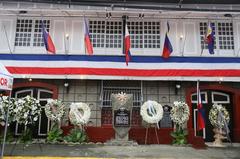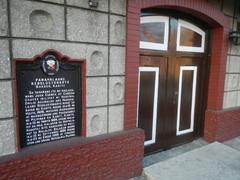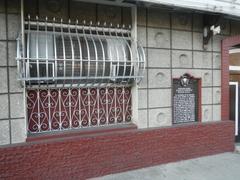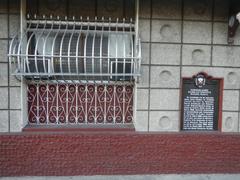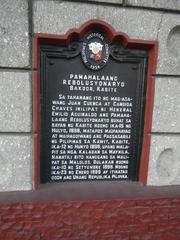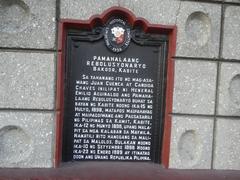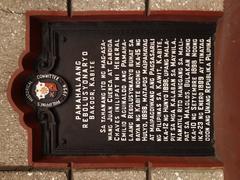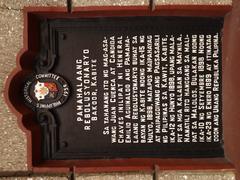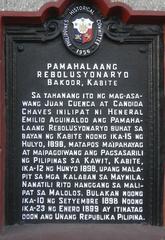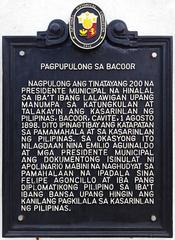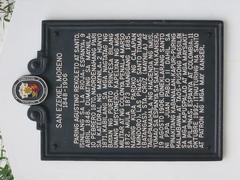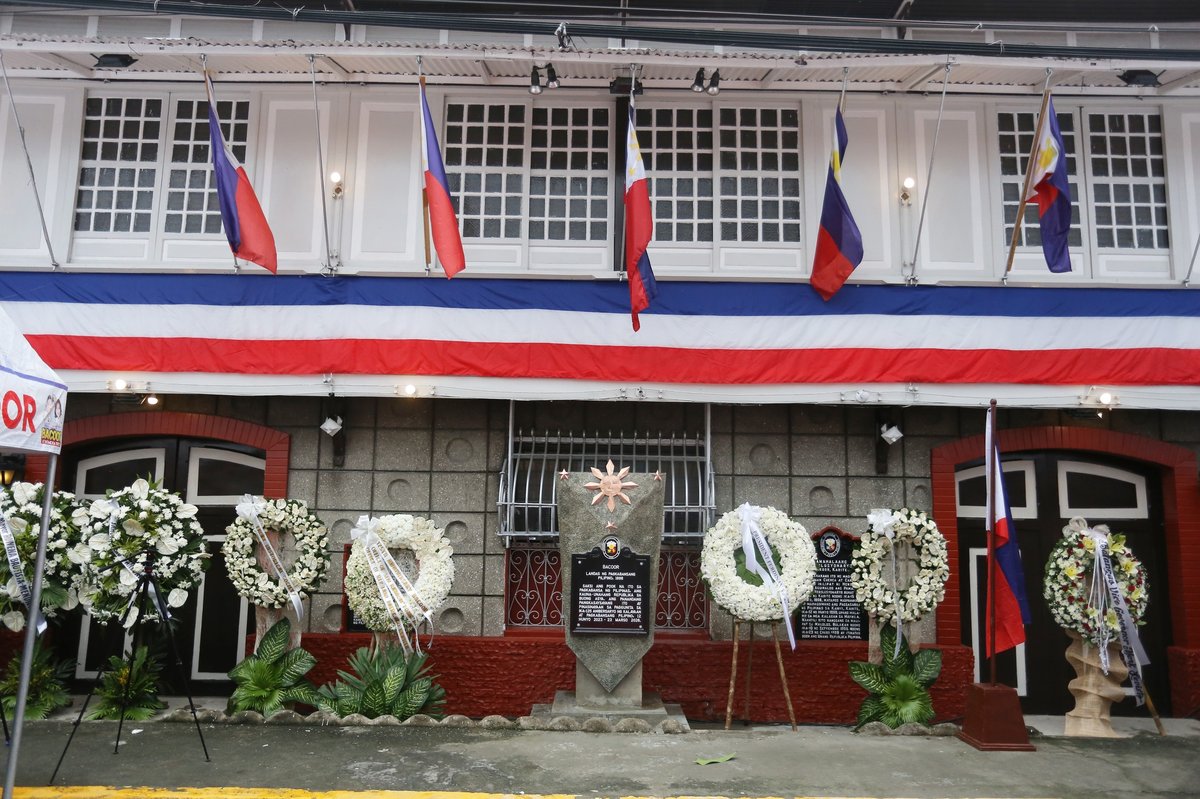
Revolutionary Government Historical Marker Bacoor: Visiting Hours, Tickets, and Comprehensive Guide
Date: 14/06/2025
Introduction
Bacoor, Cavite, is etched into the fabric of Philippine history as the first seat of the revolutionary government established by General Emilio Aguinaldo in 1898. The city’s pivotal role in the nation’s struggle for independence is immortalized by the Revolutionary Government Historical Marker, prominently located at the Cuenca Ancestral House—locally known as Bahay na Tisa. This landmark commemorates the historic Bacoor Assembly of August 1, 1898, where nearly 200 provincial leaders ratified the Declaration of Philippine Independence, solidifying Bacoor’s place in the formation of the First Philippine Republic.
This guide provides detailed information on Bacoor’s revolutionary heritage, including historical context, site accessibility, visiting hours, tickets, travel tips, and nearby attractions. Whether you are a history enthusiast, student, or traveler, this resource will help you explore Bacoor’s enduring contribution to Philippine nationhood and connect with the spirit of Filipino nationalism (Bacoor City Official Website, National Historical Commission of the Philippines, Philippine News Agency).
Table of Contents
- Early History of Bacoor
- Bacoor’s Role in the Philippine Revolution
- The Bacoor Assembly and the Ratification of Independence
- National Impact and Historical Legacy
- Key Historical Sites and Visiting Information
- Visiting Hours, Tickets, and Accessibility
- Travel Tips and Transportation
- Nearby Attractions
- Special Events and Guided Tours
- Visitor Experience and Practical Information
- Frequently Asked Questions (FAQ)
- Conclusion and How to Learn More
1. Early History of Bacoor
Bacoor’s roots extend to pre-colonial settlements along Manila Bay, where it thrived as a trading center for Chinese and local merchants. During the Spanish colonial era, Bacoor became part of friar-owned haciendas, serving as both an agricultural center and a crucible for early anti-colonial resistance.
2. Bacoor’s Role in the Philippine Revolution
Cavite, including Bacoor, was vital to the 1896 Philippine Revolution. Bacoor’s proximity to Manila and control of major routes made it a strategic base. Notable events include the Cavite Mutiny of 1872, the martyrdom of Fr. Mariano Gomez (a Bacoor native), and the pivotal battles that helped liberate Cavite from Spanish rule.
3. The Bacoor Assembly and the Ratification of Independence
On August 1, 1898, Bacoor hosted the historic assembly where local leaders from at least 15 provinces ratified the June 12 Declaration of Philippine Independence. The assembly, presided over by General Aguinaldo and with the guidance of Apolinario Mabini, ratified the Act of Independence—an act that symbolized the collective will of the Filipino people and the formalization of the revolutionary government (PNA).
4. National Impact and Historical Legacy
Foundation of the First Philippine Republic
Bacoor’s significance lies in its role as the bridge between the Declaration of Independence in Kawit and the formal establishment of the First Philippine Republic in Malolos, Bulacan. The events and principles ratified at Bacoor influenced the Malolos Congress and the promulgation of the Malolos Constitution—the first in Asia (NHCP).
Recognition and Commemoration
While often overshadowed by other historic sites, Bacoor’s role is increasingly recognized through commemorative efforts, such as scholarly publications and the installation of the Revolutionary Government Historical Marker (Scribd). The Cuenca Ancestral House and its marker are central to these efforts.
Influence on National Identity
The assembly at Bacoor exemplified unity, participatory democracy, and the assertion of Filipino sovereignty—principles that continue to shape the nation’s political identity.
5. Key Historical Sites and Visiting Information
Revolutionary Government Historical Marker
- Location: Cuenca Ancestral House (Bahay na Tisa), Calle Real, Bacoor Poblacion
- Significance: Marks the site of the revolutionary government’s first headquarters and the Bacoor Assembly (Bacoor Tourism: Bahay na Tisa)
- Visiting Hours: Outdoor marker accessible daily from 6:00 AM to 6:00 PM; best viewed during daylight hours
- Tickets: No entrance fee
Cuenca Ancestral House (Bahay na Tisa)
- Description: Spanish-era heritage house, privately owned, with visible marker on the façade
- Public Access: Exterior view anytime; interior access during select public tours or special events
Zapote Bridge
- Significance: Site of key battles during the revolution
- Visiting Hours: 8:00 AM to 6:00 PM
- Tickets: Free
St. Michael the Archangel Parish
- Established: 1752
- Visiting Hours: 7:00 AM to 7:00 PM
- Special Events: Annual feast in September (Bacoor Tourism)
6. Visiting Hours, Tickets, and Accessibility
- Marker Accessibility: Publicly accessible 6:00 AM–6:00 PM; no ticket required
- Cuenca House Interior: Open during festivals or special tours (minimal donation may apply)
- Wheelchair Access: Paved walkways; some heritage buildings have steps and uneven flooring
7. Travel Tips and Transportation
- From Manila: Take a bus, jeepney, or van bound for Bacoor from terminals in Pasay, Lawton, or Coastal Mall; nearest LRT station is Baclaran
- By Car: Use CAVITEX or SLEX; parking is limited
- On Foot: Key sites are within walking distance in Bacoor Poblacion
- Best Time to Visit: Dry season (November–April); early mornings or late afternoons to avoid crowds and heat
8. Nearby Attractions
- Molino Dam: Historic site ideal for nature walks
- Bacoor Riverwalk: Scenic stroll along the river
- Las Piñas-Parañaque Critical Habitat: Birdwatching site
- Aguinaldo Shrine (Kawit) and Battle of Alapan Monument (Imus): Other stops on the Philippine Independence Trail
9. Special Events and Guided Tours
- Bakood Festival (September): Cultural performances, parades, and house tours (Festivalscape)
- Independence Day (June 12): Wreath-laying ceremonies and reenactments
- Guided Tours: Offered during festivals or by arrangement with the Bacoor City Tourism Office
10. Visitor Experience and Practical Information
- Dress Code: Light, modest attire; respectful clothing for church visits
- Amenities: Nearby cafés, eateries, public restrooms, and souvenir shops
- Safety: Area generally safe; exercise standard precautions; sidewalks can be narrow
- Photography: Allowed for marker and exteriors; seek permission for interiors or professional shoots
11. Frequently Asked Questions (FAQ)
Q: What are the visiting hours for the marker?
A: Accessible daily from 6:00 AM to 6:00 PM.
Q: Is there an entrance fee?
A: No, visiting the marker is free.
Q: Are guided tours available?
A: Yes, during festivals or by arrangement with Bacoor City Tourism.
Q: Is the site accessible for people with disabilities?
A: The marker area is accessible; the ancestral house has steps and uneven floors.
Q: Can I take photos?
A: Yes, for the marker and exterior. Permission needed for interior or professional photography.
Q: What other attractions can I visit nearby?
A: St. Michael the Archangel Parish, Zapote Bridge, Bacoor Riverwalk, and Aguinaldo Shrine in Kawit.
12. Conclusion and How to Learn More
The Revolutionary Government Historical Marker in Bacoor is a vital link to the nation’s quest for independence. Free to visit and easily accessible, it offers a powerful glimpse into the events that shaped the Philippines. Enhance your visit by joining guided tours, attending special events, or using digital resources like the Audiala app for interactive content and maps.
Stay updated on events and visitor information through the Bacoor City Official Website, National Historical Commission of the Philippines, and Bacoor’s official social media channels. Don’t miss the chance to walk through history and celebrate Bacoor’s legacy as the birthplace of the revolutionary government.
References
- Bacoor City Official Website
- National Historical Commission of the Philippines
- Philippine News Agency
- Festivalscape: Bakood Festival
- Trip the Islands: The Highlights of Bacoor, Cavite
- Lifestyle Inquirer: Cavite Land Shrines, Monuments
- Scribd: BACOOR CLUP Chap1 Introduction
- People Places PH: 7 Well Known Historical Sites Cavite
- Bacoor Tourism: Bahay na Tisa
- Bacoor Tourism: St. Michael the Archangel Church
